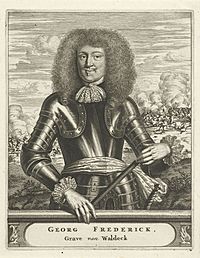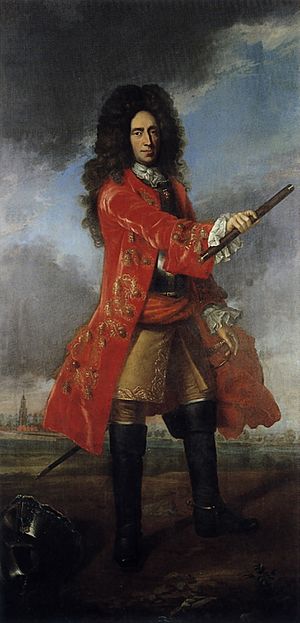Prince Georg Friedrich of Waldeck facts for kids
Quick facts for kids
Prince Georg Friedrich of Waldeck
|
|
|---|---|

Georg Friedrich of Waldeck, by Christiaan Hagen
|
|
| Born | 31 January 1620 Arolsen, County of Waldeck |
| Died | 19 November 1692 (aged 72) Arolsen, County of Waldeck |
| Allegiance |
|
| Service/ |
Dutch States Army |
| Rank | Field marshal |
| Battles/wars |
|
| Spouse(s) | Elisabeth Charlotte of Nassau-Siege |
Prince Georg Friedrich of Waldeck (born January 31, 1620 – died November 19, 1692) was an important military leader. He served as a Field Marshal for both German and Dutch armies. For the last three years of his life, he was also the Grand Master of the Order of Saint John (Bailiwick of Brandenburg).
Georg Friedrich was known for his military skills and leadership. He played a key role in many wars and political changes during his time. His career shows how leaders moved between different countries and armies in 17th-century Europe.
Contents
Early Career and Political Changes
Georg Friedrich began his military career in 1641. He joined the army of the States-General of the Netherlands. This was an important step in his journey as a military commander.
Serving Brandenburg
In 1651, he started working for Brandenburg, a powerful German state. He quickly rose to a very high position as a minister. He made big changes to Brandenburg's foreign policy. He ended their alliance with the Emperor. Instead, he tried to create a group of Protestant princes to work together.
In 1656, he helped form an alliance with Sweden. He led the cavalry in the Battle of Warsaw (1656) against Poland. However, he was removed from his position in 1658. This happened when Frederick William, Elector of Brandenburg made peace with Poland.
Major Battles and Commands
After leaving Brandenburg, Georg Friedrich continued his military service. He fought for different countries and leaders.
Fighting for Sweden and the Holy Roman Empire
He fought alongside Charles X Gustav of Sweden against Denmark. In 1664, he served as a German Reichsfeldmarschall (a high military rank). He fought near Sankt Gotthard.
In 1683, he led Bavarian troops during the famous Battle of Vienna. This battle was very important in stopping the Ottoman Empire's advance into Europe. In 1685, he fought as a freelance commander. He served the Duke of Lorraine and the Elector of Bavaria.
Leading Forces in the Nine Years' War
In 1688, William III went to England to become king. Georg Friedrich was then made Field Marshal of William's forces. This was during the War of the Grand Alliance in the Spanish Netherlands.
He won a victory at the Battle of Walcourt in 1689. However, the next year, he faced a big defeat. This was at the Battle of Fleurus. He was defeated by Marshal Luxembourg.
In 1691, Marshal Luxembourg again outsmarted him. Georg Friedrich was defeated at the Battle of Leuze. After this defeat, Waldeck was appointed chief-of-staff of the Dutch States Army. He passed away on November 19, 1692, in Arolsen.
Family Life
Georg Friedrich was the son of Count Wolrad IV of Waldeck-Eisenberg. His mother was Anna of Baden-Durlach. She was the heir to the Lordship of Culemborg in what is now the Netherlands.
On November 29, 1643, Georg Friedrich married Elisabeth Charlotte in Culemborg. She was born on March 11, 1626, and died on November 16, 1694. Elisabeth Charlotte was the daughter of Count William, Count of Nassau-Siegen. Her mother was Countess Christiane of Erbach.
Georg Friedrich and Elisabeth Charlotte had nine children together:
- Wolrad Christian (1645 – 1650)
- Friedrich Wilhelm (1649 – 1651)
- Karl Wilhelm (1650 – 1653)
- Louise Anna (1653 – 1714), who married George IV, Count of Erbach-Fürstenau
- Charlotte Amalie (1654 – 1657)
- Friedrich Wilhelm (1657 – 1670)
- Karl Gustav (1659 – 1678)
- Sophie Henriette (1662 – 1702), who married Ernest, Duke of Saxe-Hildburghausen
- Albertine Elisabeth (1664 – 1727), who married Philipp Louis, Count of Erbach-Erbach
Georg Friedrich did not have any sons who lived longer than him. After his death, his lands in Waldeck-Eisenberg went to another branch of the Waldeck family. The Lordship of Culemborg in the Netherlands was inherited by his daughter Louise Anna. After Louise died without children in 1714, it went to Sophie Henriette's son, Ernest Frederick I. He later sold it in 1748.
See also
 In Spanish: Jorge Federico de Waldeck-Eisenberg para niños
In Spanish: Jorge Federico de Waldeck-Eisenberg para niños


